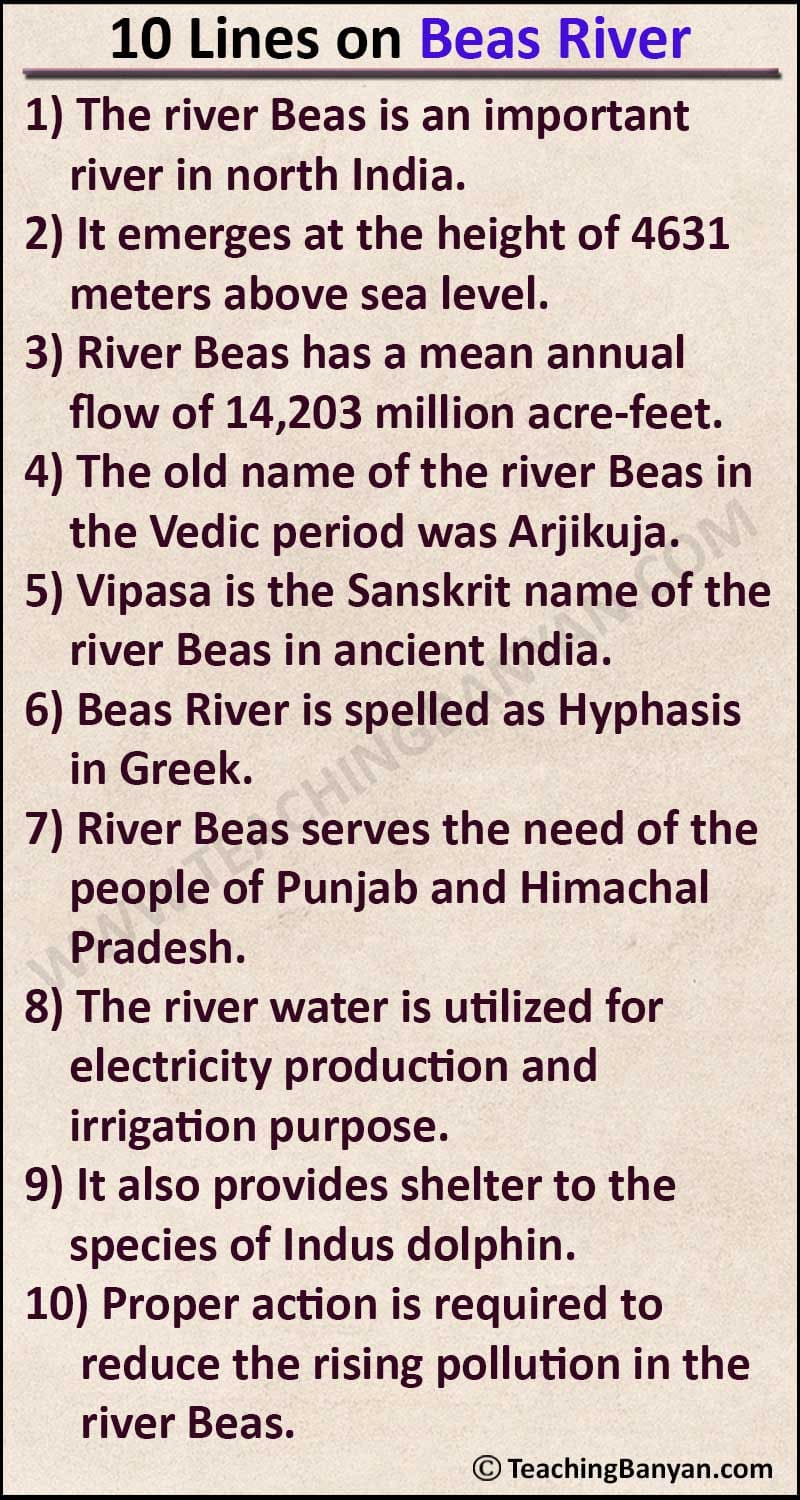Beas River is one of the five most important rivers flowing into Punjab. Not only Punjab, but Beas is an important river in India also. We should have some basic information about the river for which we have created some sets of 10 lines on Beas River below. You should check all of them once.
Ten Lines on Beas River
Set 1
1) Beas River is the second easternmost among the five rivers in the Punjab region.
2) Part of Himalaya in Himachal Pradesh is the point of origin of Beas River.
3) The total length of the Beas River is 470 km with overall coverage up to 20,303 square km.
4) Beas River rises 14,308 ft above sea level on the southern portion of Rohtang pass.
5) From Rohtang pass, Beas River flows through Kullu valley and moves to Kangra valley.
6) After crossing Kangra valley, Beas River enters into Punjab and assimilates in Sutlej River.
7) Sutlej River continues into Pakistan’s Punjab province which further joins Chenab River.
8) After meeting Beas and Sutlej, river Chenab forms Panjnad River which joins Indus.
9) Beas River forms the world’s famous valleys named as ‘Kullu’ and ‘Kangra’ valleys.
10) Bain, Banganga, Luni, and Uhaul rivers are some important tributaries of the river Beas.
Set 2
1) Beas River is a river that emerges in northwestern India.
2) It is one of the five rivers that flow in the Punjab region.
3) Beas Kund in Himachal Pradesh is the originating place of the river Beas.
4) Beas River is 470 km in length.
5) The name of the river is named after the author great Indian epic Veda Vyasa.
6) It flows through Punjab and Himachal Pradesh of India.
7) The area of the drainage basin of the Beas River is 20,303 square km.
8) Bain, Banganga, Luni, Uhal are the tributaries of the river Beas.
9) According to the Indus water treaty, the water of the Beas River is allocated to India. 10) This river was called the sorrow of Punjab before the construction of the Pong Dam.

Set 3
1) The river Beas is an important river in north India.
2) It emerges at the height of 4631 meters above sea level.
3) River Beas has a mean annual flow of 14,203 million acre-feet.
4) The old name of the river Beas in the Vedic period was Arjikuja.
5) Vipasa is the Sanskrit name of the river Beas in ancient India.
6) Beas River is spelled as Hyphasis in Greek.
7) River Beas serves the need of the people of Punjab and Himachal Pradesh.
8) The river water is utilized for electricity production and irrigation purpose.
9) It also provides shelter to the species of Indus dolphin.
10) Proper action is required to reduce the rising pollution in the river Beas.
Set 4
1) Beas River is a transboundary river of northern India and one of the five rivers of the state of Punjab.
2) Beas River from the Himalayas meets River Sutlej in Punjab covering 470 km.
3) Nadaun, Mandi, Dehra-Gopipur, Pandoh and Sujanpur Tira are some cities on the bank of river Beas.
4) Beas River was called “Vipas” in “Rigveda” which means unfettered, later on, in Sanskrit, it was called “Vipasa” and ancient Greeks called Beas River as “Hyphasis”.
5) “Veda Vyas” who wrote the epic Mahabharata is the eponym of Beas River, his name is considered to be taken from a source lake called Vyas Kund.
6) The great sages Vishwamitra, Narada, Parashar, Parashuram, Vyas, Kanav and Vashisht came here on various occasions and meditated on the banks of Beas River.
7) Beas River is marked as the easternmost border of Alexander the Great conquests in 326 BC, it was the Beas River that created a problem for him to invade India.
8) According to the great composition “Kavyamimansa” of Rajashekhara, the Gurjar-Pratihara kingdom monarch “Mahi Pala I” extended its territory up to Beas River.
9) In the present 21st century, Beas River was re-developed under the Beas project for irrigation and hydroelectric power generation purposes.
10) The second phase of “Pong Dam” was completed early in 1974 followed by the first phase having 140 km upstream in the year 1977.
River Beas is not only fulfilling the needs of the people who are living on the nearby banks with water, agriculture, irrigation and transportation but lots of irrigation and hydroelectric projects are also built up to provide electricity for every household. The Pong and Pandoh dams, which were built in 1974, are providing electricity to the entire Punjab and Himachal Pradesh. Beas River is not only the lifeline of India, but it is the lifeline of Pakistan too.
